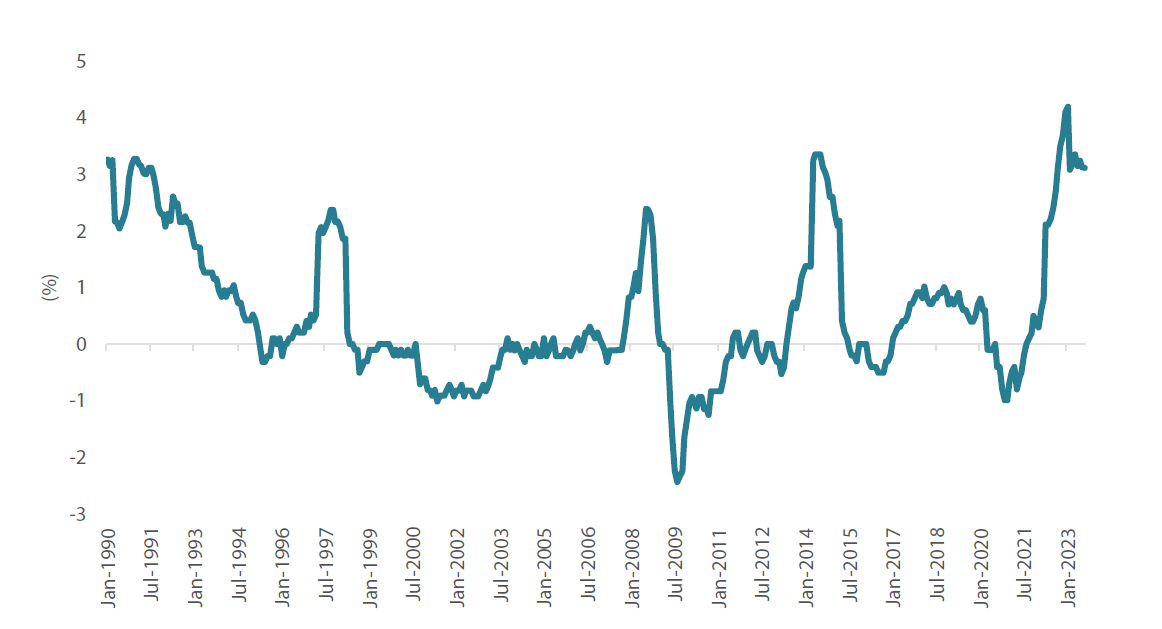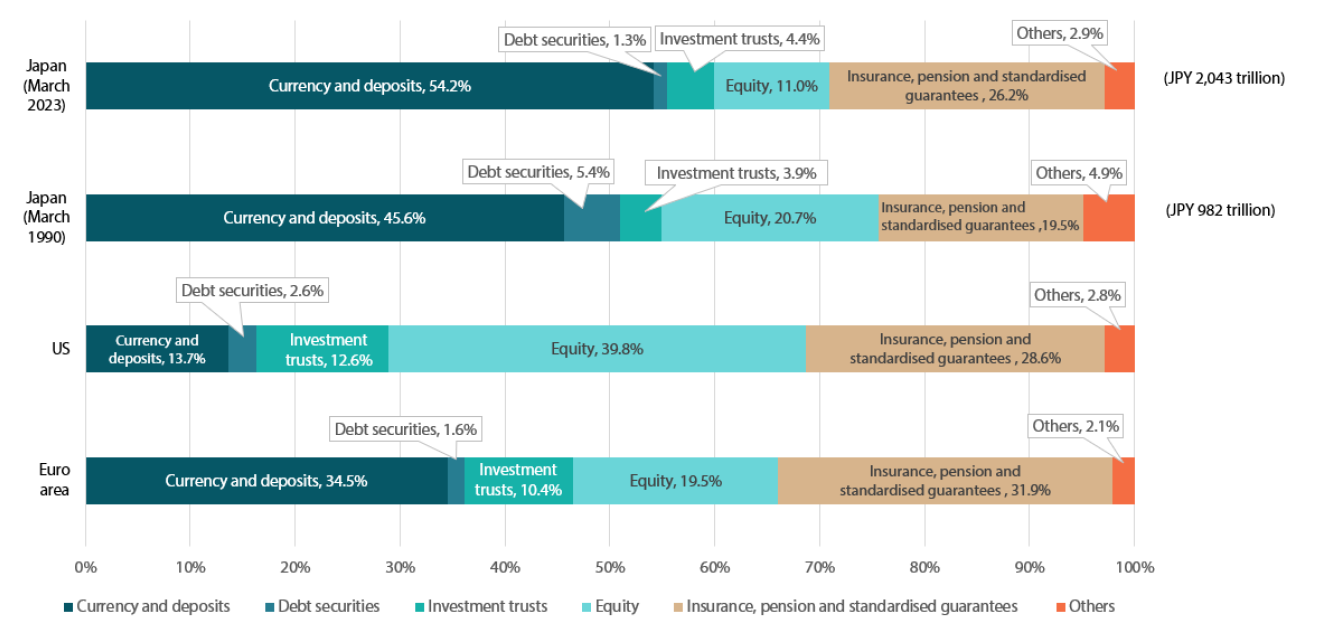Inflation, financial markets resurgence in focus after a turnaround year
As the end of another year draws closer, 2023 may be remembered as a turning point for Japan—a year that marked a comeback for the world’s third largest economy. The country’s stock market has been one of the best performers globally so far during the year and foreign investors, many of whom were long-term sceptics, increasingly view Japan with grudging optimism. The reasons for the stock market’s robust performance have been well documented, ranging from corporate governance reforms, benefits from a weaker yen, attractive market valuations and the ebbing threat of deflation. Looking towards 2024, we place particular focus on two developments that we believe point to the country’s revival: inflation regaining a foothold and signs of resurgence by the financial markets.
First development: inflation regaining a foothold
Since the bursting of the Japanese economic “bubble” in the early 1990s, which brought stock and real estate prices crashing down, deflationary pressure took hold Japan in the following decades. As economic growth faltered after the bursting of the bubble, consumers lost confidence and opted to save rather than spend; demand decreased and deflation took hold. The Bank of Japan (BOJ) was tasked with freeing the economy from the deflationary malaise, which had a notably negative impact on wages. The central bank embarked on years of unorthodox monetary easing to combat deflation, but the results were mixed. It was not until the COVID-19 pandemic when the BOJ’s 2% inflation target actually began to look sustainable.
Inflation in Japan initially took hold due to external pressures as global supply-chain and energy disruptions in the wake of the pandemic and the onset of the Russia-Ukraine war drove up prices. However, signs began to emerge of “demand-pull” inflation generated by domestic demand and higher wages, hinting that the rise in prices is becoming more sustainable. Labour shortages became acute with businesses scrambling to hire workers as the economy reopened after the pandemic, increasing upward pressure on wages. As Chart 1 shows, the rate of wage increases has reached a 30-year high, having risen sharply as Japan emerged from the pandemic.
Chart 1: Rate of wage increases*, 1990-2023

* Based on the average wage method
Source: Japanese Trade Union Confederation data compiled by Nikko AM
The rise in wages has been in part a reaction to the surge in prices. Japan’s core consumer price index (CPI) excluding fresh foods rose 3.1% year-on-year in August 2023, remaining above the BOJ’s 2% target for the seventeenth consecutive month (Chart 2). Consumers, having lived for decades in a deflationary environment, initially showed aversion to the rise in prices. However, many now appear to be accepting inflation as a part of life; according to the Cabinet Office’s September 2023 consumer confidence survey, a little over 50% of the surveyed households expect prices to have risen more than 5% in a year’s time. With wages climbing amid support from the government (Japanese Prime Minister Fumio Kishida has vowed to deliver “structural wage growth”) and prices expected to keep rising in the longer term, inflation finally appears to have gained a foothold in Japan.
Chart 2: Japan’s core CPI from1990 to 2023

Source: Statistics Bureau of Japan data compiled by Nikko AM
Second development: Japan’s financial markets primed for a resurgence
We believe that the stage is set for a resurgence by the Japanese financial markets, which have gone through periods of stagnation since the bursting of the bubble in the early 1990s. This is thanks to two developments: the beginning of the end of ultra-easy monetary policy by the BOJ and the surge in equities.
For more than two decades the BOJ has pursued a series of novel monetary easing schemes in a bid to free the Japanese economy from deflationary pressures. Even now the BOJ remains the only central bank among its developed market peers still in the easing camp. However, change is in the air. In December 2022, the BOJ surprised the markets by lifting the cap it had imposed on long-term Japanese government bond (JGB) yields from 0.25% to 0.50%. Under this scheme, known as yield curve control (YCC), the central bank restricts how high long-term yields can rise, in effect controlling the shape of the entire yield curve. The policy tweak was hailed as a baby step towards BOJ policy normalisation, indicating a tacit acknowledgement that inflationary pressures were beginning to build and that its YCC-related bond purchases were reducing JGB market functionality. In July 2023 the BOJ further loosened its grip on the YCC scheme by raising the cap on long-term yields to 1%.
As for equities, both the Nikkei 225 and TOPIX indices have gained approximately 20% so far in 2023, outpacing their developed market peers such as the S&P 500 (+10%), Germany’s DAX (+7%) and the UK’s FTSE (-1%). The robustness of Japanese equities in 2023, in our view, reflects the effort domestic companies are making to improve their profitability (such as their ROEs) and raise their corporate value. Reflecting Japanese companies’ increasing earning power, Ministry of Finance data showed that corporate profits (excluding those of the finance and insurance sectors) reached a record high of 31.6 trillion yen in the April-June quarter, marking an 11.6% year-on-year increase. Japanese corporate earnings have a high leverage to Japan’s nominal GDP growth. We estimate Japanese corporate earnings to grow at around 9% under a nominal GDP growth rate of 3%. We expect this to be achieved over the medium term, becoming the biggest driver of the Japanese equity market. In addition, we expect the market to also benefit from the Japanese government’s initiative to lure some of the vast savings held by domestic households into risk assets including equities.
Tapping vast household savings: 2024 could be the year of NISA
Japanese leaders have for years nudged Japanese households to invest more rather than hold their savings in cash. Prime Minister Kishida is the latest leader to embrace the savings-to-investments agenda. Under his initiative the savings scheme known as the Nippon Individual Savings Account (NISA)—which allows tax benefits but only for a limited time period—will be revamped in 2024 with the tax-free feature made permanent.
Chart 3 shows that of the roughly Japanese yen (JPY) 2,000 trillion of Japanese households’ assets, 54.2% are held as cash and deposits offering virtually nothing in terms of returns. Such a choice may have made some sense under deflation, as cash and deposits did not lose value. However, if inflation rises at a pace of 2% as we expect, the cash and deposits will lose that much of their value every year. We therefore expect households to gradually transfer their cash holdings into equities and bonds when inflation becomes sustained.
Chart 3: Allocation of assets held by Japanese households

Source: Bank of Japan
Assuming that asset allocations return to 1990 levels, we expect households to have enough purchasing capacity to buy JPY 196 trillion in stocks and JPY 83 trillion in bonds (Chart 4). Of the JPY 196 trillion that could be allocated to equities, about half are expected to be invested in foreign stocks with the remaining half making their way into Japanese stocks. Divided over a 10-year time period, that would amount to households investing nearly JPY 10 trillion into Japanese equities every year. When the revamped NISA is rolled out in 2024, it could become a major conduit funnelling household savings into Japanese equities.
Chart 4: Expected stock and bond purchases if household assets are returned to March 1990 allocations

Source: Bank of Japan, Nikko AM calculations
Conclusion: long-term revival ahead for Japan
We believe that a long-term revival looms for Japan. Deflationary pressures are dissipating amid rising wages. The financial markets are headed for a resurgence, supported by robust stocks—which could benefit further from a re-allocation of the country’s vast household savings—and BOJ monetary policy headed towards normalisation after decades of unorthodox easing. Against such a backdrop, it may not be a stretch to imagine a world in which Japan’s policy rate is no longer negative but positive, the benchmark JGB yield, currently at 10-year highs, rising yet further, the nominal GDP growing at a meaningful rate for the first time in decades and the Nikkei probing bubble era peaks—all towards the end of 2026.




